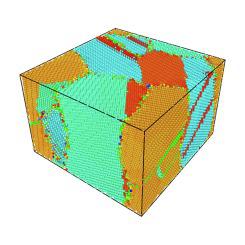当前位置:
X-MOL 学术
›
Comp. Mater. Sci.
›
论文详情
Our official English website, www.x-mol.net, welcomes your feedback! (Note: you will need to create a separate account there.)
Natural-like generation of grain boundary models and the combined effects of microstructural elements and lithiation on the plastic behavior of TiO2: A computational study
Computational Materials Science ( IF 3.3 ) Pub Date : 2024-04-04 , DOI: 10.1016/j.commatsci.2024.112989 Takuma Okamoto , Anastassia Sorkin , Keisuke Kameda , Manabu Ihara , Hao Wang , Sergei Manzhos
Computational Materials Science ( IF 3.3 ) Pub Date : 2024-04-04 , DOI: 10.1016/j.commatsci.2024.112989 Takuma Okamoto , Anastassia Sorkin , Keisuke Kameda , Manabu Ihara , Hao Wang , Sergei Manzhos

|
Microstructural features of ceramics have a significant effect on mechanical properties and ion transport in different technologies ranging from optical materials to renewable energy generation and storage. Atomistic modeling is usually done on postulated grain boundaries which may not account for the distributions of different grain boundaries in real materials. We generate microstructural features of TiO with molecular dynamics (MD) by simulating a heat treatment; in this way, a natural-like distribution of grain sizes and boundaries is obtained. We used a model system with about 545,000 atoms and obtained structures with average grain sizes ranging about 6 to 12 nm and trending with the annealing temperature. While the model is nano- rather than micro-meter structured, it present key microstructural features. We observe ‘clean’ grain boundaries as well as boundaries with an amorphous interlayer. The clean boundaries feature low-index surfaces. When an amorphous interlayer is present, higher-index surfaces can be observed. The resulting structures show significant softening (reduction of maximum stress) vs. ideal crystalline titania, with isotropy of mechanical properties. Elastic constants, besides significant isotropy, show moderate stiffening due to the presence of grains. When introducing lithium, we observe segregation at grain boundaries, and lithiation of grainy structures leads to further softening.
中文翻译:

晶界模型的自然生成以及微观结构元素和锂化对 TiO2 塑性行为的综合影响:计算研究
陶瓷的微观结构特征对从光学材料到可再生能源产生和存储等不同技术中的机械性能和离子传输有显着影响。原子建模通常是在假定的晶界上进行的,这可能无法解释实际材料中不同晶界的分布。我们通过模拟热处理,利用分子动力学 (MD) 生成 TiO 的微观结构特征;通过这种方式,获得了晶粒尺寸和边界的自然分布。我们使用了大约 545,000 个原子的模型系统,获得了平均晶粒尺寸约为 6 至 12 nm 的结构,并随退火温度变化。虽然该模型是纳米结构而不是微米结构,但它呈现出关键的微观结构特征。我们观察到“干净”的晶界以及具有非晶夹层的边界。干净的边界具有低指数表面。当存在非晶中间层时,可以观察到较高折射率的表面。与理想的结晶二氧化钛相比,所得结构显示出显着的软化(最大应力的降低),并且具有各向同性的机械性能。弹性常数除了显着的各向同性外,还由于晶粒的存在而表现出适度的硬化。当引入锂时,我们观察到晶界处的偏析,并且晶粒结构的锂化导致进一步软化。
更新日期:2024-04-04
中文翻译:

晶界模型的自然生成以及微观结构元素和锂化对 TiO2 塑性行为的综合影响:计算研究
陶瓷的微观结构特征对从光学材料到可再生能源产生和存储等不同技术中的机械性能和离子传输有显着影响。原子建模通常是在假定的晶界上进行的,这可能无法解释实际材料中不同晶界的分布。我们通过模拟热处理,利用分子动力学 (MD) 生成 TiO 的微观结构特征;通过这种方式,获得了晶粒尺寸和边界的自然分布。我们使用了大约 545,000 个原子的模型系统,获得了平均晶粒尺寸约为 6 至 12 nm 的结构,并随退火温度变化。虽然该模型是纳米结构而不是微米结构,但它呈现出关键的微观结构特征。我们观察到“干净”的晶界以及具有非晶夹层的边界。干净的边界具有低指数表面。当存在非晶中间层时,可以观察到较高折射率的表面。与理想的结晶二氧化钛相比,所得结构显示出显着的软化(最大应力的降低),并且具有各向同性的机械性能。弹性常数除了显着的各向同性外,还由于晶粒的存在而表现出适度的硬化。当引入锂时,我们观察到晶界处的偏析,并且晶粒结构的锂化导致进一步软化。



























 京公网安备 11010802027423号
京公网安备 11010802027423号